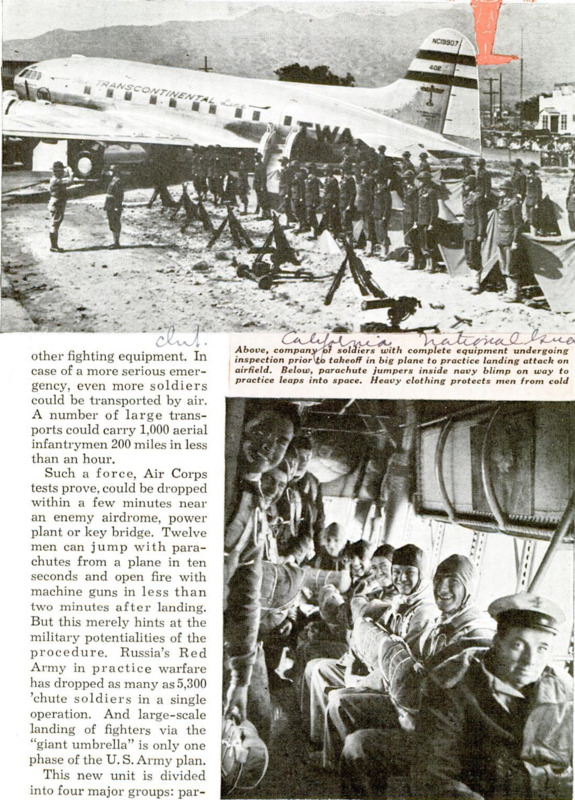"TO COMBAT sudden attacks on any of this nation’s defense bases, the U. S. army has organized a new military arm known as the Air Infantry. An attacking force with hitherto unknown mobility and speed, it can be rushed almost anywhere in record-breaking time to meet any threat of invasion. The purpose of the unit is to surprise the enemy behind the lines, disrupt communications and destroy bridges, airports and other vital military centers, with a minimum of time, effort and expense. Under the new procedure, several hundred parachute soldiers, armed with light weapons, are dropped in a military zone, followed immediately by the landing of troop planes carrying three or four hundred heavily armed infantry-men, machine guns and other fighting equipment. In case of a more serious emergency, even more soldiers could be transported by air. A number of large transports could carry 1,000 aerial infantrymen 200 miles in less than an hour. Such a force, Air Corps tests prove, could be dropped within a few minutes near an enemy airdrome, power plant or key bridge. Twelve men can jump with parachutes from a plane in ten seconds and open fire with machine guns in less than two minutes after landing. But this merely hints at the military potentialities of the procedure. Russia’s Red Army in practice warfare has dropped as many as 5,300 ‘chute soldiers in a single operation. And large-scale landing of fighters via the “giant umbrella” is only one phase of the U.S. Army plan. This new unit is divided into four major groups: parachute detachments, detachments landed by airplane, a combination of the two, and high-speed aerial transportation of war equipment and supplies. The landing of troops by plane and parachute was achieved by the Germans with spectacular success in several of its recent conquests, notably in Norway. Their experience has shown that parachute landing units under certain conditions may serve as a quick means of disorganizing the control of troops and communications of the enemy. “Jumpers,” for instance, armed with pistols, rifles and machine guns, could seize an air field or other strategic objective and | cover the landing of squadrons and transports carrying infantry and artillery. This might further exert a decisive influence on the course of operations and bring about complete defeat of the | enemy in a particular area. Two widely separated “test spots” in the south are being used by the Air Corps to develop its new striking force. A special unit, known as the 501st Battalion, created out of the Twenty-ninth Infantry at Fort Benning, Ga., is pioneering the work with parachutes. The main experimental unit for working out new methods for carrying troops and equipment by planes is the Ninth Infantry Regiment at Fort Sam Houston, Tex. In command of the parachutists is Maj. William B. Miley, an infantryman who also graduated from the Air Corps tactical school. He has introduced tumbling as part of the training of his troops. It keeps them in shape and helps them in landing, he says. The battalion, numbering 412 men and fifteen officers, soon will have its own training field. A 900-acre tract next to the Fort Benning air field has been set aside for their use, and two 350-foot training towers will be built. They will be similar to those now owned by a commercial firm at Hightstown, N. J., which were used to train some of the veteran members of the battalion. One of the towers will be used for “controlled” jumps, opening the "chutes by mechanical means and guiding their course downward. The other will open the “umbrellas” mechanically, but will permit free descents. Training procedure has several phases. First, each man must learn how to prepare and fold his own ‘chute. Next he is given thorough instruction, on the ground, concerning how to jump. He is told that the umbrella takes about one and three-fifths seconds to open. Steering is done by pulling down the shrouds on the side toward which the jumper is headed. Now the parachutist is ready to jump. But he isn't allowed to go aloft, even on the training tower, until he learns to fall properly from an eight-foot platform. Next he takes to the tower and finally to the air. The entire course takes four to six weeks. Practice is conducted regularly in collapsing 'chutes to prevent being pulled by the wind after landing. No jumps are made from less than 750 feet, though it is known that men could “bail out” from as low as 300 feet. It is not necessary to pull a ripcord since the silk envelope opens aboard the plane as the jumpers go out. Each man carries a spare 'chute. Six Jandings, each of them well nigh perfect, are required to qualify as a parachute soldier. One is a “spot” landing in which the jumper must land at a designated spot, meantime making thorough calculations as to the speed of the plane, altitude, wind currents and weather. Although the unit is equipped with tommy guns, machine guns and folding bicycles, officers have a feeling that the 'chutists will carry with them only a pistol and a hand grenade. Tests indicate that jumpers can learn to fire their pistols and throw their grenades with reasonable accuracy while in the air. Machine guns, in the new procedure, probably will be lowered by special parachute, simultaneously with the mass jumping of the parachutists. Many interesting conclusions have been produced by the tests recently conducted at Fort Sam Houston, Tex., concerning the carrying of troops and fighting equipment by air. Entire regiments can be transported with comparative ease. Carrying the regimental equipment, however, is a problem, for no less than twelve thirty-seven-millimeter guns must be packed in planes. Each of the guns weighs 950 pounds and with its crew of nine, ammunition, rifles and water, fills one plane. Cargo planes, with their wide doors, must be used, and then the gun must be rolled in with less than an inch clearance, It's no trouble at all, loading an infantry battalion. Combat elements of such a unit, consisting of thirty-one officers and 838 enlisted men and equipment weigh around 200,000 pounds, or 100 tons. Each Army transport can carry a load of about two tons on normal hauls and 3,300 pounds when carrying extra fuel for a long hop. Fifty transports can carry a battalion of infantry on a mission not requiring extra gasoline loads. The unit would carry sufficient ammunition and supplies to conduct limited operations for twenty-four hours. Each rifle company, complete with light machine guns, mortars and automatics, weighs about 43,000 pounds and can be carried in eleven airplanes. The heavy weapons company, including mortars and fifty-caliber machine guns, fills twelve planes. Experiments are now under way concerning the carrying of artillery by planes. Tests of this type were conducted by the Air Corps eight years ago. In Panama ten bombers transported an entire battalion of field artillery by air for the first time in history. It required only seventeen minutes to load the artillery, which consisted of three-inch mountain howitzers. The guns were flown from Bejorca, Panama, to La Chorrera, Canal Zone. The entire movement, involving a trip of about eighty miles, was completed in a little over an hour from the time word was received of the imaginary invasion; and military experts believe that today it could have been achieved in half that time. Only twelve minutes after their arrival at the Chorrera landing field the howitzers were in action, firing on an imaginary enemy.
 Popular Mechanics, vol. 75, n. 4, 1941
Popular Mechanics, vol. 75, n. 4, 1941



